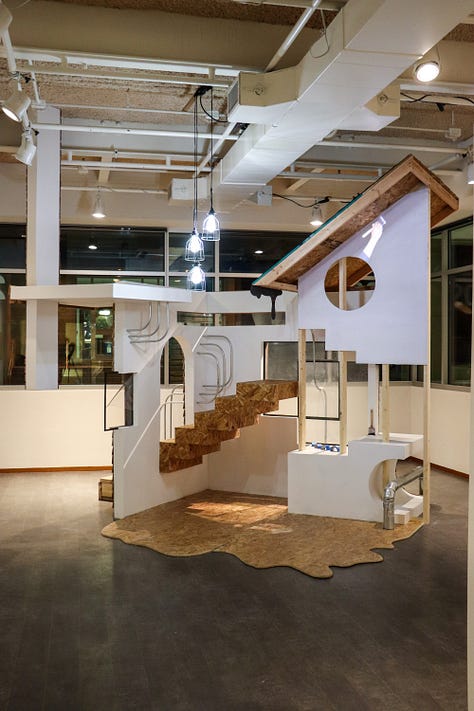This post is part of a series of features highlighting the work of emergent visual artists exhibiting in the Carlow University Art Gallery in Pittsburgh, Pennsylvania whose work intersects with the mission of Art Care.
The installation, Eternal Repair by Joshua Challen Ice, tells the story of a renovation gone wrong. In a failed attempt to recreate his grandfather’s hunting cabin that was passed down to him, Ice works through a grandson’s inheritances in all its valences: genetic, physiological, psychological, and material worth, through the intersectional processes of labor, maintenance, and care. Ice’s sculpture, which is a collection of unmoored high modernist architectural signifiers, images what is left of his inherited hunting cabin: a fragmented half-renovated tiny home filled with nonsensical solutions to self-made problems that disrupts function replacing it with metaphor. Mixing contemporary minimal aesthetics with construction-site drywall, bare two by fours, and rustic remnants, Ice works through the absurdity of recreating a paradoxical hunting cabin, an isolated rural dwelling and icon of masculinity, in a city gallery space, an interconnected and highly visible urban environment. As such, Eternal Repair presents a meditation on the ideas and processes of care, time, memory, and place explored through architecture and art-making that mines both the paradox and the surprising intersections of Ice’s vocation as an artist and his grandfather’s vocation as a tradesman taking inventory of what is passed down and what is disavowed.
Working with his hands framing walls and setting scaffolds, Ice noticed parallels between the architecture being repaired and his own body’s breakdown by the physicality of this act of repairing. As such, Eternal Repair visualizes an exploration of the maintenance of self, or self-care, through the maintenance and care of architecture as an embodied form. This embodiment is actualized through a single channel video projected directly on the sculpture depicting scenes of Ice’s fragmented body engaged in the mundane acts of construction–spackling, sanding, painting–animating the sculpture as an analog of the body while offering brief vignettes that memorialize the creation of the work.
Eternal Repair emerged from Ice’s misremembering of his grandfather’s cabin. The artist works through these memory processes in a series of incoherently humorous marked-up architectural plans. These drawings, which have a quality of adolescent posturing, visually narrate the stutters, blanks, and imaginaries of Ice’s imperfect memory rendering the structure as a wholly new creation. Through the displacements offered by humor and by deliberate failure as a generative act of care, Ice offers up reparative critiques of masculinity as a rebuttal to the arrogance of avant garde artistic ideologies. This is most evident in Eternal Repair’s mashup of high modernist-International Style architectural forms with backwoods DIY aesthetics.



In the sculpture’s architectural forms, Ice visually “name checks” canonical 20th century modernist architects such as Frank Lloyd Wright who made such bold artistic claims like “corners are fascist” and Adolf Loos who drafted a manifesto declaring the relationship of ornament and crime. Ice quotes the styles of these famous and foundational architects calling attention to the absurdity of their proclamations and destabilizing their ideological certainty and belief that architecture can change society. Instead, Ice’s work gazes inward, linking his present with his grandfather’s past and finding a shared connection through embodied architecture that manifests in a desire to engage in an eternal repair of the self and of others.
In this sense, Eternal Repair engages with the contemporary art genre of Maintenance Art, a conceptual and performance practice first articulated by Mierle Laderman Ukeles in her influential “Manifesto for Maintenance Art 1969!”. In the document, Ukeles describes two systems of labor: development and maintenance. Development describes linear works of highly visible creation such as most object-centered art and architecture. It is characterized as an auteur-driven and implicitly male labor that is concerned with being productive in a capitalist sense. According to Ukeles, the labor of development results in a “pure individual creation; the new; change; progress, advance, excitement.”
In contrast, maintenance work is a cyclical, invisible labor associated with caregiving, women, and domestic work. Here, Ukeles’ concept of maintenance connects with what Angela Garbes describes as the ungendered action of “mothering,” an action and labor that is inefficient, cyclical, and measured by daily rhythms that are continually reset. There is no end, no culmination, no static product, yet this labor is foundational to society. Ukeles characterizes maintenance labor as a form of sustainability that keeps “the dust off the pure individual creation; preserv[ing] the new; sustain[ing] the change; protect[ing] progress.”
Ice’s Eternal Repair combines both forms of labor: the linear, male gendered work of individual creation in the form of a work of architecture as art, and the feminine-coded cyclical labor of maintenance, care, and repair that emerges through his reimagining, relocation, and reproduction of his grandfather’s legacy. The abode itself is a manifestation of the physicality of manual labor as a gesture of care and a shared labor by Ice in his artistic practice and his grandfather’s work as a tradesman during his life. Ice states that these forms of labor in relation to the body “creates cycles of injured to healed, and broken to repaired, paralleling the life cycle of architecture” and its perpetual breakdown and maintenance. Here the linkages between the day-to-day work of both artistic creation and blue-collar labor, where one’s living is made through one’s body, is imaged in Eternal Repair forming a tangible connection between presence and memory through architecture.



